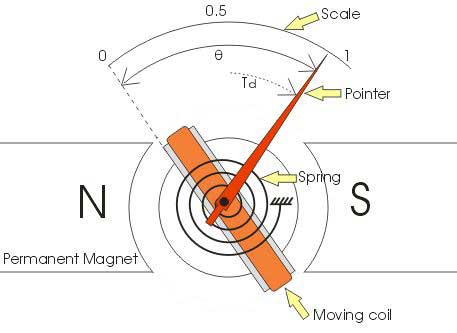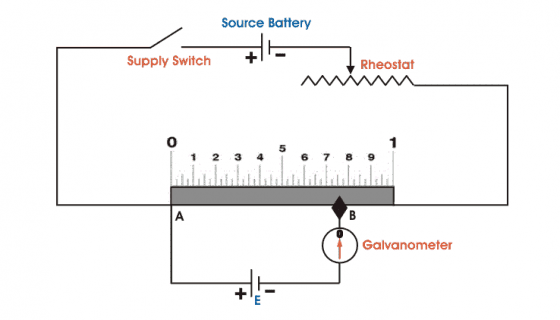Types of Electrical Measuring Instruments:
Electrical measuring instruments are used to measure electrical parameters. The common uses of electrical measuring instruments are current, voltage, and resistance measurements. Other electrical measuring instruments include capacitance, inductance, and frequency measurements.
To get an accurate reading of electrical parameters such as voltage, current, and resistance, the electrical measuring instruments must be calibrated. There are many calibration methods used in electrical measuring instruments which depend on the measurement type. This entails connecting them to a known standard or device with similar properties.
Current measurements: Voltage across a fixed resistor is proportional to the current flowing through it. The current can be measured by connecting a resistor in series with the circuit and measuring the voltage across the resistor.
Voltage measurements: The voltage between two points can be measured by connecting a voltmeter in parallel with the load.
Resistance measurements: Resistance is measured by applying a known voltage across a resistor and measuring the current flow.
Capacitance measurement: Capacitance is measured by applying a known voltage and measuring the charge that accumulates on the capacitor plates.
Inductance measurements: Inductance is measured by applying a known current and measuring the voltage across the inductor.
Frequency measurements: Frequency is measured by counting the number of times the waveform repeats in a given period.
Indicating instruments are used to display the voltage, current, or power of electricity. The indicating instrument is also known as a meter. Types of indicating instruments: indicating instruments may be analogue or digital. Commonly used indicating instrument types include voltmeters, ammeters, and wattmeters. Indicating instruments can further be classified by their technology such as electromagnetic indicating instruments, magnetic indicating instruments, and thermal indicating instruments.
Measurements involve the use of instruments as a physical means of data mining quantities or variables.
The history of the development of electrical measuring instruments is divided into three categories.
1)Mechanical measuring instruments
2)Electrical measuring instruments
3)Electronic measuring instruments
In this article, we will discuss only types of electrical measuring instruments. Electrical methods of indicating the output of the detectors are more Rapid than mechanical methods. It is unfortunate that an electrical system normally depends upon a mechanical meter movement as indicating device. This mechanical movement has some inertia and therefore these instruments have a limited-time response.
Electrical measuring instruments are classified into two categories. They are
1) Absolute instruments
2) Secondary instruments
1) Absolute instruments::
These absolute instruments give the magnitude of the quantity under measurement in terms of the physical constants of the instrument. These absolute instruments are standard and are used in laboratories. Examples of these instruments are the tangent galvanometer Rayleigh’s current balance.
2) Secondary instruments::
These instruments are so constructed that the quantity being measured can only be measured by observing the output indicated by the instrument. The instruments are calibrated by comparison with absolute instruments or another secondary instrument that has already been calibrated against an absolute instrument.
Working with absolute instruments for routine work is time-consuming since every time a measurement is made, it takes a lot of time to compute the magnitude of the quantity under measurement. Therefore secondary instruments are most commonly used. Absolute instruments are seldom used except in standard institutions while Secondary instruments find usage almost in every sphere of measurement. A voltmeter, a glass thermometer, and a pressure gauge are examples of secondary instruments.
These secondary instruments are classified into 3 types :
1) Indicating instruments
2) Recording instruments
3) Integrating instruments
1) Indicating instruments ::
These instruments will give instantaneous values of the quantity to be measured. The scale and pointer mechanisms are invalid. PMMC, MI, dynamometer wattmeter, frequency meter, and power factor meter are examples.
2) Recording instruments::
These instruments record the value to be measured or observed. Recorded over graph paper with a lightweight pen. These are used to observe load variation continuously. Examples are recording voltmeter, recording wattmeter, and storage oscilloscope.
3) Integrating instruments::
These instruments add the measured value to the existing value. These instruments will give the total electricity consumed over a period of time. Energy meter or KWhr meter,kVARh meter, and ampere-hour meter.
Depending on the way electrical instruments present results of measurements they can be classified into 2 major categories.
1) Deflection type instruments
2) Null type instruments
1) Deflection type instruments::
 In these deflection types instruments, the deflection of the instrument provides a basis for determining the quantity under measurement. The measured quantity produces some physical effect with deflects are produces a mechanical displacement of the moving system of the instrument. An opposing effect is built in the instrument which tries to oppose the deflection or the mechanical displacement of the moving system. The opposing effect is closely related to the deflection or mechanical displacement which can be directly observed. The opposing effect is so designed that its magnitude increases with the increase of reflection or mechanical displacement of the moving system caused by the quantity under measurement. The balance is achieved when the opposing effect equals to cause producing the deflection or mechanical movement. The value of the measured quantity can then be inferred from the deflection or mechanical displacement at the point of balance. This is how deflection-type instruments work.
In these deflection types instruments, the deflection of the instrument provides a basis for determining the quantity under measurement. The measured quantity produces some physical effect with deflects are produces a mechanical displacement of the moving system of the instrument. An opposing effect is built in the instrument which tries to oppose the deflection or the mechanical displacement of the moving system. The opposing effect is closely related to the deflection or mechanical displacement which can be directly observed. The opposing effect is so designed that its magnitude increases with the increase of reflection or mechanical displacement of the moving system caused by the quantity under measurement. The balance is achieved when the opposing effect equals to cause producing the deflection or mechanical movement. The value of the measured quantity can then be inferred from the deflection or mechanical displacement at the point of balance. This is how deflection-type instruments work.
2)Null type instruments::
 In these null-type instruments, a zero or null Indication leads to the determination of the magnitude of the measured quantity. In contrast to deflection type instruments, a null type instrument attempts to maintain the deflection at zero by suitable application of an effect opposing that generated by the measured quantity. Therefore for the operation of a null type instrument, the following are required:
In these null-type instruments, a zero or null Indication leads to the determination of the magnitude of the measured quantity. In contrast to deflection type instruments, a null type instrument attempts to maintain the deflection at zero by suitable application of an effect opposing that generated by the measured quantity. Therefore for the operation of a null type instrument, the following are required:
i) the effect produced by the measured quantity
ii) the opposing effect whose value is accurately known. This is necessary in order to determine the numerical value of the measured quantity accurately
iii) a detector that detects the null conditions that are a device that indicates zero deflection when the effect produced by the measured quantity is equal to the effect produced by the opposing quantity. The detector should be capable of displaying unbalance i.e., a condition when the effect produced by the measured quantity is not equal to the opposing effect.
There is another way in which electrical measuring instruments may be classified. This classification is based on the functions they perform. The three main functions are explained below:
1) Indicating function::
Instruments and Systems use different kinds of methods for supplying information concerning the variable quantity under measurement. Most of the time this information is obtained as a deflection of a pointer of a measuring instrument. In this way, the instrument performs a function which is known as indicating function.
2) Recording function::
In many cases, the instrument makes a written record usually on paper, of the value of the quantity under measurement against time or against some other variable. Thus this electrical instrument performs a recording function. For example, a potentiometric type of recorder used for monitoring temperature records the instantaneous values of temperatures on a strip chart recorder.
3) Controlling function::
This is one of the most important functions, especially in the field of industrial control processes. In this case, information is used by the instrument or the system to control the original measured quantity. Thus there are three main groups of electrical instruments. The largest group has the indicating function. Next in line is the group of instruments that have both indicating and recording functions. The last group falls into a special category and performs all three functions i.e., indicating, recording, and controlling.